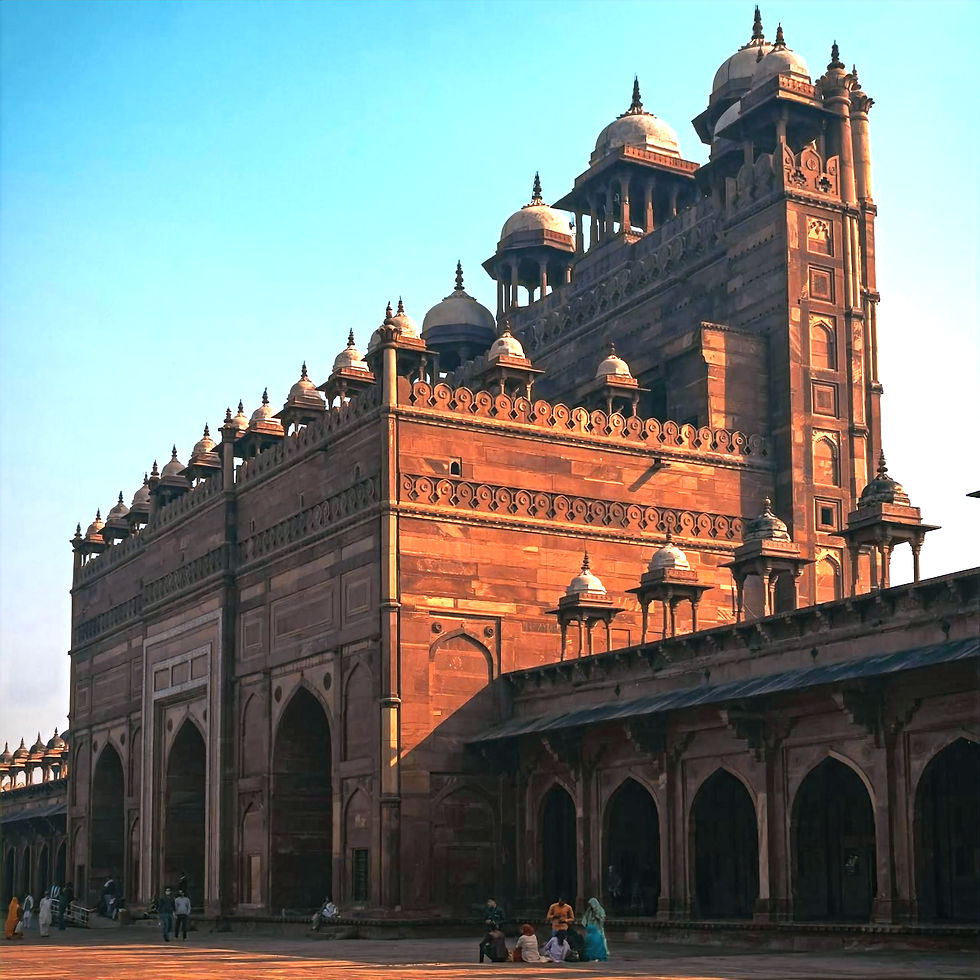Exploring North India: Iconic Sites of History and Splendour (Part 1)
- Brenelle D'Souza

- Feb 23, 2024
- 3 min read
Updated: Jul 27, 2024
North India boasts a vibrant history, where ancient monuments and architectural wonders narrate tales of bygone eras. From the majestic Taj Mahal to the formidable Red Fort, this region is home to some of the most significant historic landmarks in the world. Each site offers a unique glimpse into the cultural and architectural legacy of empires that once ruled this land.
Here’s a guide to exploring the most iconic historic sites and monuments in North India, promising an unforgettable journey through time.
1. Taj Mahal, Agra: The Epitome of Love

Historical Significance:
The Taj Mahal, an architectural marvel built by Mughal Emperor Shah Jahan in memory of his beloved wife Mumtaz Mahal, stands as a symbol of eternal love. Completed in 1653, this UNESCO World Heritage Site is renowned for its stunning white marble façade, intricate carvings, and beautiful gardens.

Travel Tips:
Best Time to Visit: October to March for pleasant weather.
Entry Fees: Purchase tickets online to avoid long queues.
Must-See: Visit at sunrise or sunset for breathtaking views.
2. Red Fort, Delhi: A Mughal Masterpiece

Historical Significance:
The Red Fort, constructed by Emperor Shah Jahan in 1648, served as the main residence of the Mughal emperors. This UNESCO World Heritage Site features impressive red sandstone walls, beautiful gardens, and the iconic Lahori Gate, symbolizing India's rich Mughal heritage.

Travel Tips:
Best Time to Visit: October to March.
Entry Fees: Tickets can be bought online or at the entrance.
Must-See: Attend the evening light and sound show to learn about the fort’s history.
3. Qutub Minar, Delhi: A Towering Achievement

Historical Significance:
The Qutub Minar, standing at 73 meters, is the tallest brick minaret in the world. Commissioned by Qutub-ud-din Aibak in 1193, this UNESCO World Heritage Site marks the beginning of Muslim rule in India. The complex includes the Quwwat-ul-Islam Mosque and the Iron Pillar, which mysteriously resists rusting.

Travel Tips:
Best Time to Visit: October to March.
Entry Fees: Tickets are available online and at the site.
Must-See: Climb the tower for a panoramic view of Delhi (when open).
4. Amber Fort, Jaipur: A Rajput Jewel

Historical Significance:
Located in the town of Amer, Jaipur, Amber Fort, a magnificent palace-fort built in the 16th century by Raja Man Singh, is a splendid example of Rajput architecture. Perched on a hilltop overlooking Maota Lake, this UNESCO World Heritage Site features grand courtyards, ornate palaces, and the famous Sheesh Mahal (Mirror Palace).

Travel Tips:
Best Time to Visit: October to March.
Entry Fees: Tickets can be bought at the entrance.
Must-See: Take an elephant ride to the fort's entrance or enjoy the sound and light show in the evening.
5. Fatehpur Sikri, Uttar Pradesh: The Abandoned City

Historical Significance:
Fatehpur Sikri, a UNESCO World Heritage Site, was built by Emperor Akbar in the late 16th century. This abandoned city, made of red sandstone, served as the Mughal capital for a short period. Key attractions include the Buland Darwaza, Jama Masjid, and the tomb of Salim Chishti.

Travel Tips:
Best Time to Visit: October to March.
Entry Fees: Tickets are available online and at the site.
Must-See: Explore the palaces, mosques, and public buildings that showcase Mughal architectural brilliance.
Exploring the iconic sites of North India provides a captivating journey through centuries of grandeur and architectural brilliance. Whether standing in awe of the Taj Mahal's beauty or wandering the halls of the Red Fort, each visit enriches your understanding of India's diverse cultural heritage. Stay tuned for Part 2, where we continue to uncover more of North India's historic treasures, offering deeper insights into this fascinating region's storied past.
To discover more historical travel destinations and recommendations, follow EraTrails.com and get the latest posts in your inbox. We'd love to hear your feedback and ideas.
.png)



Comments